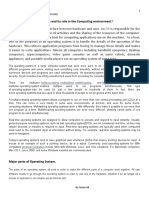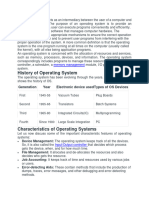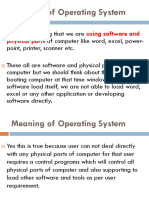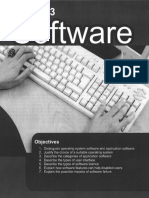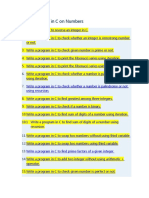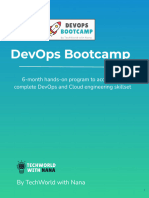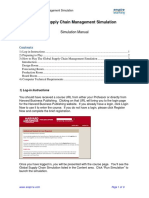Unit 5 : Software
Learning Objectives
Learners will learn to:
describe the purpose of operation systems
understand which tasks are carried out by the operating system
identify the characteristics of operating systems including: Command Line
Interface (CLI), Graphical User Interface (GUI), dialogue based and gesture
based interface
Vocabulary
operating system
interface
Let Us Start
Hey, I know what an operating
system is. It is something that Well, you are on the right track! An
runs on computers. But I am not operating system is like the brain of a
entirely sure what it does. computer. It manages all the hardware
and software, allowing you to interact
with the computer and run different
programs.
1
�Let Us Explore
Fill in the blank using the given words to find how a computer system works.
Works Useless Useful
1. Only hardware ____________________________
2. Hardware + Operating system ____________________________
3. Hardware + Operating system + MS Office ____________________________
Get, Set, Go
5.1 Operating system
An operating system is software installed on a computer's hard drive that enables the
computer hardware to communicate and operate with the system and application
software. A computer and software programs would be useless without a computer
operating system.
2
�Some examples of the operating system are Microsoft Windows, Apple MAC OS and
Linux.
5.2 Role of the operating system
The functions of the operating system are given below.
File management
The file manager controls all of the different files on the system, e.g. text files,
graphic files and program files. It controls file permissions, such as the user's ability
to see, open, write, or delete a file.It helps to organise and control files so that they
are as easy to use as possible for the user. It can help to protect the user from
accidental mistakes too.
Device management
Operating system handles all the devices that are connected to the computer system.
It includes input devices such as a keyboard and mouse. It also includes output
devices such as a monitor and printer. It communicates with the devices through
software called drivers. These translate the instructions by the device manager into
one the devices can understand. Peripherals like a mouse, keyboard and printer need
drivers to communicate with the software.
Memory management
Memory management handles the RAM. Programs use RAM throughout their
operation. Some programs will be large and complex and use the RAM extensively,
whereas some are very small programs and won’t use it as much. Memory
management checks all requests from programs are valid and allocates accordingly.
It will deallocate space and swap out data to virtual memory. It will ensure overall
that different programs can be open at the same time.
3
�Security
System security is how the operating system can stay protected and ensure that
elements are monitored and actioned to ensure the system is secure.
Some areas of security are:
Creating/Deleting users for the system
Providing access level rights, e.g. administrator rights over installing,
modifying a system or accessing files or folders. This is compared to standard
rights of just accessing and using software/files on the system.
Auditing the files that involve keeping a log of file edits, deleted files and the
creation of files.
Protecting from threats, viruses, worms, malware or remote hacker attacks.
Security updates to fix security issues in the operating system.
Check For Understanding
Draw a between each operating system function and its description.
Function Description
File management It checks all requests from programs are valid and
allocates memory accordingly.
Device management It ensures that the operating system can stay
protected and elements are monitored.
Memory management It controls file permissions, such as the user's
ability to see, open, write, or delete a file.
Security handles all the devices that are connected to the
computer system
4
�5.3 User interface
The system that people use to interact with a computer to give it commands, to see
the results of those commands, etc., is known as the user interface.
Types of user interface
Command-line User Interface (CUI)
A CLI allows the user to interact with the system by typing specific commands. There
are no graphics or icons you would commonly find on devices such as a smartphone
or tablet computer; instead, the user enters text at a command prompt. It is at this
prompt that the user can issue commands that are executed by the system. The main
benefits of a CLI include the fact that it requires a low amount of secondary storage
and RAM as there are no graphics. Experienced users and system administrators
often prefer a CLI as it allows greater control over the computer system than
restrictions often applied to a graphical user interface.
Graphical User Interface (GUI)
A GUI is an interface built around visual things. They are considered a user-friendly
interface as they are designed to be visual. A GUI includes graphics, so there is a
requirement for a higher capacity of secondary storage and RAM. In a graphical user
interface:
5
� Windows are regions of the screen used to display information
Icons are small pictures that represent folders, software, etc.
Menus are lists of options the user can select from
A pointer is an arrow that can be moved around the screen and is used to
select things
Did you Know?
A GUI is sometimes called a WIMP interface:
Windows, Icons, Menus, Pointer
Dialogue-based User Interface
It is an interface that uses spoken words to interact with the computer. In return, the
computer responds with actions or further spoken words.
Dialogue interfaces can sometimes be found in mobile devices (e.g. Siri in an iPhone),
in-car entertainment, home entertainment systems (e.g. Amazon Alexa or Echo) and
home automation systems (e.g. lighting, curtains).
6
�Gesture-based interface
Gesture-based user interface refers to using specific gestures, like
scrolling, pinching, and tapping, to open the interface. This
recognition technology has evolved from basic motions and
applications to complex, and it is now part of everyday life for
many people.
Activity 1
Which user interface would you use if designing a car satellite navigation system (an
electronic system for route guidance) and why?
__________________________________________________________________________________________
__________________________________________________________________________________________
__________________________________________________________________________________________
__________________________________________________________________________________________
__________________________________________________________________________________________
__________________________________________________________________________________________
__________________________________________________________________________________________
__________________________________________________________________________________________
__________________________________________________________________________________________
__________________________________________________________________________________________
Unit Review
1. An operating system is software installed on a computer's hard drive that enables
the computer hardware to communicate and operate with the system and
application software.
2. The functions of the operating system include file management, device
management, memory management and security.
7
�3. The system that people use to interact with a computer to give it commands, to
see the results of those commands, etc., is known as the user interface.
4. Different types of operating systems are command-line user interface, graphical
user interface, dialogue-based user interface and gesture user interface.
Check for Understanding
1. Select the correct answer.
1) The main function of an operating system is to:
a. Manage computer hardware and software resources
b. Create and edit documents
c. Connect to the internet
2) Which operating system is commonly used in Apple Macintosh
computers?
a. Windows
b. Linux
c. Mac OS
3) What does the file-handling function of the operating system do?
a. Check for viruses and malware
b. Create, move, rename and delete files
c. Print data
4) What kind of interface requires the user to type in commands from a
keyboard to give the computer instructions?
a. Graphical user interface
b. Command-line user interface
c. Dialogue-based user interface
2. Answer the following questions.
a. A desktop computer uses the operating system. Explain why this type of
computer needs an operating system.
___________________________________________________________________________________
___________________________________________________________________________________
___________________________________________________________________________________
8
� ___________________________________________________________________________________
___________________________________________________________________________________
___________________________________________________________________________________
___________________________________________________________________________________
b. Describe the device management task of the operating system.
____________________________________________________________________________________
____________________________________________________________________________________
____________________________________________________________________________________
____________________________________________________________________________________
____________________________________________________________________________________
____________________________________________________________________________________
____________________________________________________________________________________
c. Differentiate between a command-line user interface and a graphical user
interface.
___________________________________________________________________________________
___________________________________________________________________________________
___________________________________________________________________________________
___________________________________________________________________________________
___________________________________________________________________________________
___________________________________________________________________________________
___________________________________________________________________________________
___________________________________________________________________________________
___________________________________________________________________________________
d. Describe gesture-based user interface.
_______________________________________________________________________________
_______________________________________________________________________________
_______________________________________________________________________________
9
� _______________________________________________________________________________
_______________________________________________________________________________
_______________________________________________________________________________
_______________________________________________________________________________
_______________________________________________________________________________
Project Work
Create a list of tasks performed by the operating system.
Lab Activity
Create a presentation on the user interface of a computer. Add the following
information.
What it is
Types
Advantages
Disadvantages
10
�Resources
https://www.computerscience.gcse.guru/theory/operating‐system
Reference Material
https://www.youtube.com/watch?v=K9lqlNHWhaA
11














